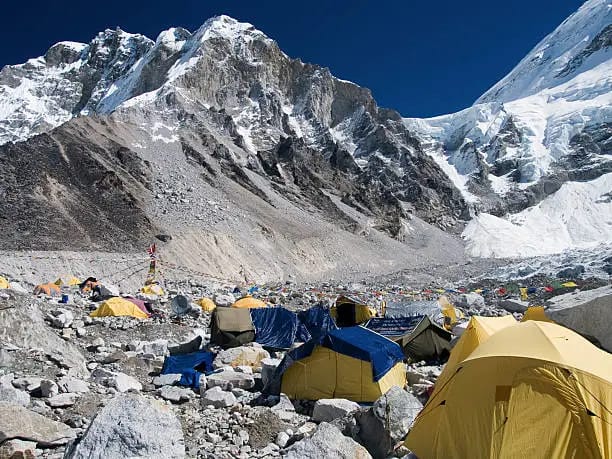Essential Gear for the Everest Base Camp Trek
Going on the Everest Base Camp trek requires that you pack your traveling kit with all essential gears to guarantee a safe, comfortable and pleasurable adventure. Trekkers need the right equipment to travel safely over sometimes difficult and a often changing terrain, considering they will be at elevations well above more than 5000 meters.
Footwear Footwear is the cornerstone of every hiking gear list. Trekking boots: proper trek sturdy pair of walking shoes or preferably a good water proof and well-insulated one to help with grip on rocky tracks. You should definitely wear in these boots before your trek to avoid blisters! Paired with good performance trek socks you get great moisture management and blister prevention.
The weather in the Himalayas is typically quite changeable, so layered clothing is a necessity. A moisture-wicking base layer (to wick sweat away from the skin) and a insulating mid-layer, like this fleece jacket for when its really cold on exposed trail. A waterproof, breathable shell (i.e. rain jacket) is mandatory to keep you and your insulation from getting wet because weather can change rapidly in the mountains if there’s a bit of clouds on top like here… Some thermal gloves, a warm hat and get yourself a buff / neck gaiter to battle the cold at altitude.
Again, a well-fitted backpack is also very important. A backpack between 40 and 60 liters should work for your personal items, extra clothing, and snacks. You will want a pack that comes with good cushioning and is supportive enough to continue wearing after hours of hiking. Although trekking poles will not necessarily make it easier to breathe, they can provide some support when heading up or going down the mountains which could save your knees and precious balance.
As with most high-altitude treks, hydration is everything so pack a water carrier or strong H2O bottle. And on the trail it may not be easy to find potable water, and you are recommended to use some filters or purification tabs. Nutrition is as important as hydration and so energy rich snacks like nuts, power bars or dried fruit will help to keep the energy level in balance throughout the trek.
A small first aid kit containing band-aids, pain killers and altitude sickness medication. A dependable headlamp is important for very early begins or going through darkness, as well as additional batteries are a should.
Finally, health items– sunblock, chap-stick and you need UV protection sunglasses to protect against the extra radiation from the sun at higher altitude! By ensuring that this right equipment is available, any trekker can go on the Everest Base Camp Trek Packing Lists feeling fully prepared for both severe long days and undeniabely unique experiences in a landscape of distinctive beauty surrounded by Himalayan golden. Proper preparation is key for a comfortable, and not to mention enjoyable trek.
Introduction to Trekking Gear
Right trekking gear has a substantial role to play in ensuring the success and enjoyment of various trails like Everest Base Camp Trek. The correct gear is more than just comfort, its also safety for the day to have all your rear under varying weather conditions and varied terrain. As gear becomes more available, the ability to distinguish between what everything does and why it is important will become crucial.
In general, the equipment for hiking can be broken down into categories of trekking shoes and boots clothing layers insulating waterproofing Every category is designed to meet a need, whether it be for protection and support or temperature control and moisture management. Trekking can often mean long days combined with strenuous activity and being properly kitted out could be the key to lasting energy levels and overall health.
Kitting yourself out with the best possible gear for trekking conditions can reduce your risk of injury and enhance your performance. If you are an experienced hiker or a novice trekker, getting to know the essential requirements of trekking gear would offer great benefits. Equipped with the right gear, you can enjoy amazing landscapes and cultural experience while knowing that whatever challenges will come up on your way — You are ready as per best of them.
Selecting the Best Hiking Boot for your Feet
Selecting the perfect hiking boots is a decision that each trekker has to take. Proper footwear can make the difference between a hike turned nightmare and an enjoyable adventure. The best trekking boots should be robustifying such a way that they do not twist and turn when walking on rocks or uneven trails, something you find plenty of while going for high-altitude treks like Everest Base Camp.
With hiking boots, more than anything else it is fit that counts. There has to be space for your toes, but the heel must sit snug.Surely those are not news either? Buy boots with a nice arc and cushy insides to make your feet hurt less on the long hikes. Waterproofing is another must-have as mountainous terrain can change quickly: Go with boots constructed of Gore-Tex or a similar material.
Traction should also be a concern in the stirrup for safety reasons. Rubber outsoles featuring substantial lugs grip onto wet or uneven territory. You should break in your boots and them with some longer walks to prevent blisters or previous unknown discomfort.
Choose boots that you can add thermal insoles to or are insulated if walking through colder conditions. At the end of day, your investment in selecting and breaking–in the right pair of hiking boots will pay dividends by making for an enjoyable trek during which you can focus on all of the breath-taking scenery and rich culture along the trail.
Dress in Layers: The Importance of Proper Clothing
Dressing in layers is crucial when hiking to keep the body at a fare temperature, treks such as climbing to Everest Base Camp have unpredictable mountain climate. This system will be made of a base layer, insulating layers and outer shells as the final barrier from wind or water.
The moisture-wicking base layer lies adjacent to the skin and is usually constructed from rapid drying fabric. It helps to wick moisture away from the body which can help keep you dry and feeling balanced if working up a sweat on more arduous hikes. In this line of thought fabrics like merino wool or a synthetic blend would come to mind as they are often breathable and quick drying.
The insulating layer traps heat, helping to ward off the cold. It must warm you up and should maintain breathability, keeping your skin coats dry inside.@stop-start activities: go for fleece or light down that is more about insulation but not cuffs over bottom@jsnauthoring) This layer comes on and off quickly for matching with climate, as required by trekkers.
Lastly, the last piece of clothing serves as an outer layer or shell that also provides protection from wind and rain. A suitable waterproof coat and a good set of breathable pants to prevent sweatingregs_resources combine with some decent ventilation will keep you warm, dry, although free from sweat at precisely the precise same time. By adding all the layers, trekkers feel much comfortable and can be equipped for different weather conditions that they may face along with the trails leading to a more enjoyable as well successful trekking experience.
2) Insulating Layers— Fleece and Down Jackets
At places like the base of Mount Everest, trekkers must deal with cold weather conditions where insulating layers are essential to retaining body heat. Two of the best insulating materials are fleece and down, which have different advantages for various types of trekking.
Fleece jacketsThe trans-seasonal fleece is a popular material for lightweight fleeces. They really excel when it comes to warmth and, being so breathable, are excellent for high-intensity activitieS like trekking. Fleece is an excellent insulator, and can be worn underneath a waterproof shell to keep you dry while still providing insulation. Fleece also tends to dry quickly, which is important when the weather constantly shifts.
Down jackets, in contrast, are the king of warmth-to-weight ratio. Down jackets are insulated with the soft under-feathers of ducks or geese, offering exceptional warmth that is perfect for colder conditions at higher altitudes. But down loses its insulating properties when it gets wet, which is why they should be worn with a water-resistant outer layer to keep you warm and dry.
In the case of fleece vs. down, whether it is better or worse depends on what you will be going through and how much warmth protection will be needed! Earliest recommendations suggest a bit of all — so that trekker can layer for fluctuating temperatures. In short, the selection of an appropriate layer of insulation is guaranteed to upgrade the experience and comfort level for any potential trekkers travelling on challenging trails.
Water Resistant Gear: Jackets and Pants
Performance: When it comes to high-altitude trekking and the uncertain weather that you face, performance is key — there is no question of compromising on a good waterproof jacket. Special designs on jackets and pants for waterproofing are quite necessary to make trekkers keep dry and warm, even in rainy-snowy-windy condition that doesn’t take their trip quality away.
Its materials, such as Gore-Tex or similar straps that aid in keeping water from entering while providing a way for moisture to escape out. Breathability is crucial to keep you dry during a workout because sweat means chill when the temp drops. An adjustable hood, ventilated zippers and spurts in the torso of this billowy solid keeper improve fit while also make it provide better protection from the elements.
It is as important to have water resistant pants, especially for those trek keeps running with sloppy or wet grounds. Extra tip: When running for water, be sure to stick with lightweight and airy options that do not weigh you down or require additional layering. For those who are engaging in more strenuous hiking, there is also the option of ventilated zippers on many waterproof pants.
Gaiters also offer extra protection for your lower legs and feet from splashes if you wear them over the top of leggings soiling/weather conditions. Consider these with gators to keep out in mud stuff into ideal (on muddy routes). These elements unite to create a waterproof defense that ensures trekkers can fully enjoy the stunning landscapes and cultural experiences along the trail, without being impeded by any adhering discomfort experienced from sopping wet clothes. Appropriate rain gear provides shelter from the elements, making your trek far more enjoyable and proving you are a true outdoor traveller!
Advantages and Best Practices of Trekking Poles
For hikers, and particularly those embarking on a tough trail like the Everest Base Camp trek, trekking poles are an invaluable tool. These poles are a crucial part of the support and aid in saving the knee locally while going up or down, especially during steep ascends. The extra stability of trekking poles keeps the weight in equilibrium, helping trekkers to walk through uneven paths without falling down. They can be even more important in high altitude areas where foot placement is limited and every step counts.
Trekking poles can not only assist your body, they may even help with stamina. Trekkers who use their upper body are able to alleviate leg fatigue making hiking easier and more enjoyable. None of this is a big problem and results in more pleasant all-day comfort. Poles can help with gauging distances and keeping to a consistent pace.
While shopping for trekking poles, look out for features such as adjustability, weight and comfort of the grip. Customizable to your height and terrain, with lightweight options like carbon fiber poles that minimize strain. Rubber tips, that provide better grip on firm surfaces and shock absorbent construction will enhance the durability of your hiking poles. In conclusion, trekking poles can be a game changer and definitely make your treks easier so that you are able to enjoy trails otherwise would have been difficult.
Choose the perfect size and features of backpacks
If you are going for long treks like Everest Base Camp, choosing the right backpack is also essential to have a successful experience. It should be comfortable and durable, yet light enough to carry effortlessly alongside all your go-to items. For multiday treks, 40-60 liters is generally a good size so you have space for clothing, food and venison popcorn packaged treats.
Importantly, fit should be taken into account once you determine the size of backpack to get. Choose one that is appropriate for your torso length and has adjustable straps to make a customized fit. an appropriately-loaded backpack: the weight in snacks disperses down, pulling less on your shoulders and spine For example, a padded hip belt and back panels are designed for comfort to offer more support on longer hikes.
Also, take into account the organization in your backpack. With multiple compartments and pockets you would be able to easily access your frequently utilised items, such as water bottles/snacks/first aid kit. A pair of side pockets are great for cramming smaller items while a rain cover comes included to brave the elements on uncertain days.
Lastly, consider whether extra features are important to you (ie**) hydration reservoir compatibility,ventilation systems for breathability, gear loops for strapping on trekking poles or sleeping bag. In addition to increasing convenience and comfort, it will significantly give you a much more pleasant trekking experience if the choice of backpack is appropriate.
Sleeping Gear: Bags and Liners
The appropriate sleeping gear is vital to get a good night sleep while in the hotel during your trekking days on Everest Base Camp. At higher elevations, evening temps can drop quite a bit — so you will want to bring along that quality sleeping bag of yours. Choose a cold weather rated sleeping bag, best if it is insulated up to a temperature limit of below -10 (+14) Celsius Fahrenheit for better nights sleep in the cool evenings.
EBC Trek Guide Select the Insulation Type: Down or Synthetic Sleeping Bags Throw in down bags that are light, ultra packable and warm relative to their weight; or synthetic bags which insulate very well when damp (and tend to have a lower price point )… One of the recommendations is for a mummy-shaped sleeping bag, since they hug your body more snugly than square-ish bags which lose heat faster.
If you are borrowing a sleeping bag or have an older model, purchase a silk sleep sheet to help with warmth and comfort. Liners add an extra layer of warmth as well, and keep your sleeping bag clean so that they last longer. They can also be worn by themselves in warmer weather.
And don’t underestimate the need for quality sleeping pad. A pad will insulate you from the cold ground and add pitching up to a comfier land of sleep. It is frequently a trade-off between weight, comfort and insulation. Spending a bit on good quality sleeping gear is going to make the difference and you are not only getting rest for the night, but preparing yourself for next day adventure.
The navigation tools used would be maps and the GPS devices.
Trekking, especially on tough terrains like the ones you would come across at the Everest Base Camp trek, requires an equally efficient set ofnavigation tools. Although plenty of well-marked trails exist, which the average hiker can follow quite safely on footpaths longs as a Palestinian guide is present at all times.
Traditional maps are great for visualizing the lay of the land, picking out unique features and planning day to day routes. Overlays — Topographic maps reveal the elevantion giving you an idea of how much climbing is in store on certain sections. Knowing map reading is very essentials before trek; it help you to develop the skill set for navigation.
GPS devices and smartphone apps provide even more advanced options than maps. GPS watches can pinpoint your location, record a stored route or trail and give you live elevation data two. Most all of the trekking apps have offline maps which means still functioning in remote areas with no cell service.
When opting for navigation tools, you need to consider your inclinations and familiarity with technology. As helpful as using a GPS give you, it is prone to fail so always have an actual map with close by at all times. When you have a good map to follow, it is easier for your navigation and direction knowledge to be intact with confidence in the mind as all you do now when hitting the trailhead, would stare at how delicious looking that route really displays!
Water Bottles and Filters (Hydration Systems)
The next few days were essential to maintain energy and well-being during the trek on Everest Base Camp Since here in this region of high altitude and physical exertion, we reach dehydration quickly. It is important to choose the right hydration system which allows easy access of clean drinking water on-the-go.
The options to carry water with you are many, from a variety of BPA-free plastic bottles and stainless steel containers… to portable protein shake shakers where the bottle itself holds your dry ingredients in one chamber. Stainless steel bottles are great for cold water, and a collapsible bottle is light to pack. Choose a bottle with a wide mouth so you can refill it and/or clean A compatible water purification system.
Water filters/purification tablets — Remember to sanitize your water before drinking! Such devices are also widely used by trekkers as portable water filters which can remove pathogen causing disease and has been recommended for use in streams rivers etc. to allow human access waste laden with heavy metals, at the reasonable cost of $0.05 liter delivered (which cannot be achieved by many city funded plants…) [21]. Here are a few with filters already installed, to help make it easier to fill on the go. Purification tablets can also be good back-up (especially in the case of unexpected emergencies) as they are lightweight and work well for smaller volumes.
This is especially important at higher elevations, where the body dehydrates more quickly. Make sure to sip during the course of everyday even when you are not thirsty. An ideally designed hydration system will keep you rejuvenated and active, making your trek memorable and make sure that other than laying eyes on the immensity of Himalayas must also enjoy its beauty inside out.
First Aid Kit: Basic Safety Necessities
It is important for a good first-aid kit to be included in the trekking gear of all tourists, especially if you are on tough routes such as Everest Base Camp Trek. Although the goal is to prevent from any injury or disease but things needed for an urgent scenario can certainly ensure travelers safety and a belief that everything will be fine. A simple first aid kit that contains materials to address minor mishaps like cuts, scrapes and blisters is a good place to startereço.
Items to include: band-aids in different sizes, sterile gauze pads, adhesive tape for wound care. Keep antiseptic wipes and antibiotic ointment for cleaning the wound to prevent infection. You’ll also want to bring some pain relief tablets for headaches or aches. Things like ibuprofen, acetamin and aspirin will be good options in your first aid kit. Prophylaxis for altitude-related illnesses and symptomatic treatment (acetazolamide [Diamox], ibuprofen, etc. in non-SICU patients) us armed forces — Borden Institute
If you take personal medications, don’t forget to include these along with an emergency contact list. The scissors, tweezers and digital thermometer are good for a random number of situations. Do not forget to carry antihistamines if you are an allergenic person. First Aid KitPlease keep your first aid kit updated (replace expired items). It allows trekkers to deal well with minor emergencies making their trek and safer.
However, less attention was paid to the stove and cookware; both are important cooking equipment.
Camping Stove (Obviously if you are planning for a trek in the remote areas such as treks like Everest Base Camp trail then having one good gear of cooking sets can work wonders to prepare and dependent on foods which help in restoring energy.) Every trekker pretty much must have a camping stove– Go for the lightweight and compact. Some popular options are canister stoves and multi-fuel stoves that you can use with different types of fuels, offering versatility based on your own available resources.
Canister stoves are perfect for boiling water and whipping up simple meals with a minimum of fuss. They usually attach to pre-filled fuel canisters that small and lightweight. Another advantage of multi-fuel stoves is their wide selection of fuel sources (including liquid fuels that are often available in more remote areas). Nevertheless, they can still be more high-maintenance and user-dependent.
One other thing you need for efficiency, besides a stove is good quality cookware. Aluminum and titanium are durable materials that can withstand any high heat, thus the perfect choice for backpackers who want lightweight pots and pans. A foldable sink or container for dishwashing
A couple of spatulas and spoons, as well as something with which to light your oven/stove are essential cooking utensils for speedy meal prep. Pack soap (biodegradable) and a sponge for cleanup Having the right cooking equipment ensures that trekkers are able to get nourishing meals, enhance their experience and also keep enough of energy on a demanding trail.
Taking it Personal: Toiletries and Sun Protection
Personal items like toiletries and sun protection are indispensable for health and comfort during a trek on the likes of Everest Base Camp. To avoid infections and for overall good health, it is important to make hygiene a priority while out in the wild. Some basic toilettries to remember are eco-friendly soap, tooth paste and brush plus a few wet wipes which will come in handy for quick clean-ups if water is at all scarce.
Compact or Rapid Dry Travel Towel A travel towel is great for after washing! Bring any Feminine Hygiene Products, if needed as wells Personal Medicens A personal first aid kit is optional, including a few band-aids and items like lipstick or chapstick to keep from drying out at altitude.
It is also important to have sun protection since the sun becomes stronger at high altitude. A high SPF broad-spectrum sunscreen will help protect your skin when it goes out. Protect your face from the sun with UV shades and a large-brimmed hat that offers more depth and comfort on long days of hiking under heat.
When you are comfortable on the trail, so too is your health and well-being. When you take care of your hygiene and sun protection, you would be free to concentrate on the trek itself without worries in mind that makes it more fulfilling.
Photography Gear: Cameras and Other Equipment
One of the rewards of walking all over the vieewt and moments that unfold in front us while hiking to Everest Base Camp. Picking the Right Photography Gear For Perfect Photos Other trekkers carry professional cameras to capture the moment, other lighter options are mirrorless or high-end smartphone that can also produce impressive images.
If you bring a Camera DLSR or Mirrorless think about using what its called getting a lens that is easy to use all the time, such as 24–70mm pros it means your not always changing between landscapes and portraits. It may not be glamorous, but a solid (and often heavy) tripod can keep the camera stable during long exposures or windy days; you’ll have to decide whether weight is worth that stability.
Its even more important to bring extra batteries and memory cards, as the cold weather will drain your battery quicker than you think it would. Take camera bag, ensure that it is padded well and can withstand the weather elements as you hike from meal of the day to anotherMeal of The assignment using a Camera —Vista Tips_RDPhoto
Besides the camera itself, take into account also packs of lens cleansing wipes which can be used to eliminate from dirt around your site. or even moisture. A little microfiber wipe helps in keeping transparent lenses clear and smudge or free. With the right photography gear, trekkers take back a piece of this experience in their camera along with the extraordinary terrain and friendly faces.
To Sum Up: Last Minute Packing Hacks
A little bit of care and careful selection can make your Everest Base Camp trek a very successful & actually fun experience! The best way to nail down what gear, clothing and personal items you will need is by compiling a complete packing list of it all. But you need to work first on necessities that improve safety, comfort and convenience.
Lastly, choose lightweight and less bulky equipment to avoid having a heavy backpack that you would have found difficult to carry with on very long treks. Make be aware of where to spot them or use those you might just go in advance and wear on the vacation. For clothing, layering is the trick; have base layers for insulation/ keeping dry and then insulating & waterproof depending on weather conditions.
Likewise, do not forget to pack essentials n like first aid kit, cooking equipment etc as they help ensure your safety and comfort throughout the trip. Remember to throw in some personal items; such as toiletries and sunblock, after all you have to keep clean and well.
Lastly, Remember you have to pack something aim-militant. As we know, weather and trail conditions can change on a dime so the ability to fine-tune your gear will make bring more comfort into you tramping experience. Follow these packing tips, and you can head out on your Everest Base Camp Trek ready to embrace this adventure in the remotest of locations.














Post Comment